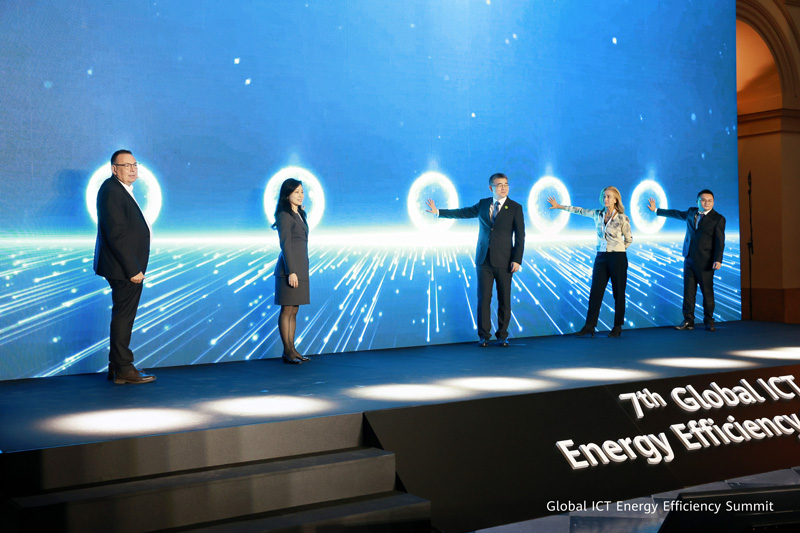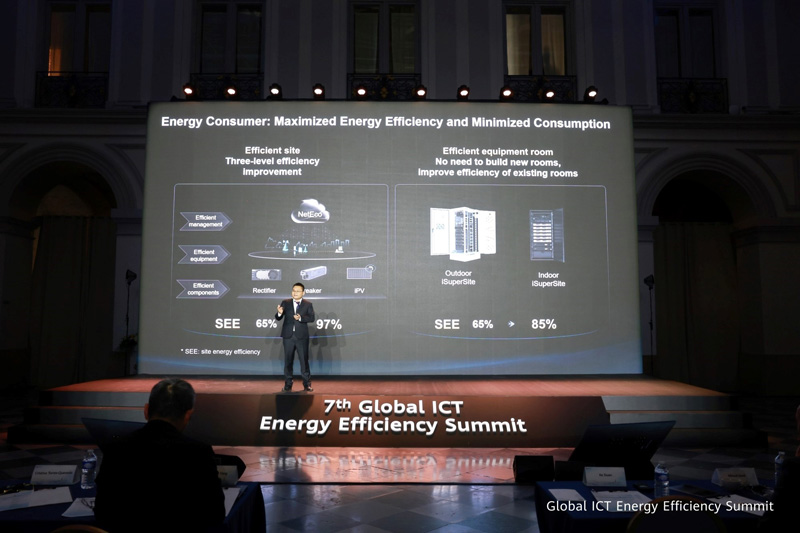[Bordeaux, France, October 24, 2023] On October 24, the 7th ICT Energy Efficiency Summit was held in Bordeaux, France, with the theme of "Green Site, Brighter Future". Top carriers and tower vendors, research institutes, standards organizations, and other key stakeholders around the world gathered and exchanged views about green transformation in the telecom industry.
The participants include Huawei Digital Power, China Southern Power Grid, Nano Energies, Orange, Telefónica, China Tower, China Mobile Design Institute, MIESCOR Infrastructure Development Corporation (MIDC), Imperial College London, GSMA, International Telecommunication Union (ITU), and Spanish Solar Photovoltaic Association (UNEF). The weighty topics of this event include how to accelerate the construction of green and low-carbon networks and unleash site potential through new modes such as the virtual power plant (VPP).
Dr Fang Liangzhou, Vice President and Chief Marketing Officer of Huawei Digital Power Technology Co., Ltd. said in his keynote speech that although carriers are under the pressure of emission reduction and higher energy costs, they can leverage their physical sites and power resources to increase revenues. For example, they can deploy distributed PV systems onsite and connect site energy storage to VPP for peak staggering or build EV charging facilities at existing sites. Green development has become a global campaign. Carriers' positioning is changing from energy consumers to energy consumers, producers, and enablers. Huawei is committed to integrating digital and power electronics technologies to help carriers succeed amid the global transition to carbon neutrality.
![[Bordeaux, France, October 24, 2023] On October 24, the 7th ICT Energy Efficiency Summit was held in Bordeaux, France, with the theme of](https://digitalpower.huawei.com/attachments/site-power-facility/f178fbe80ead4c6fa593550e542b3bcd.jpeg) Dr. Fang Liangzhou, Vice President & CMO, Huawei Digital Power
Dr. Fang Liangzhou, Vice President & CMO, Huawei Digital Power
Huawei launches the Smart VPP Solution
Now different industries around the world are striving to become carbon neutral and resort to electrification, which brings volatility to the power grid. Meanwhile, the ever-increasing proportion of renewable energy poses risks to the power grid. To address the issues, the virtual power plant (VPP) can be deployed to aggregate and schedule distributed load resources to enhance power grid stability. VPPs have high requirements on the total scale and response capability (speed, time segment, and precision) of accessed distributed resources.
Based on unique intelligent algorithms and high-performance hardware, Huawei launched a smart VPP solution featuring simple, intelligent, comprehensive. The solution is able to meet diversified scheduling requirements and is future-proof for new trends.
 Solution launch
Solution launch
Intelligent: Huawei's energy management platform implements cloud-network synergy and intelligent scheduling based on big data analysis and prediction. The VPP smart gateway and lithium batteries form a robust hardware platform, guaranteeing high concurrency, quick response, and high precision.
Comprehensive: One VPP system can integrate multiple services, such as peak staggering, demand-side response, and frequency response. In addition, the VPP system uses software algorithms to optimize scheduling, ensuring service security while maximizing VPP service revenues.
Li Shaolong, Vice President of Huawei Digital Power Site Power Facility Domain, said that Huawei's Smart VPP Solution aims to help carriers leverage existing site resources to gain new benefits. Huawei will work with grid aggregators, industry standards organizations, and other roles in the VPP industry chain to promote the commercial development of telecom sites servicing VPPs.
VPP was one of the hottest topics of this summit. Li Minhong, General Manager of China Southern Power Grid Shenzhen Power Supply Bureau, Dr Fei Teng, Education Director at Energy Futures Lab of Imperial College London, and Rostislav Ciganek, Head of International Business Development at Nano Energies, shared their views and discussed the feasibility of ICT energy storage's participation in energy flexibility in China, Europe, and beyond.
Building green telecom sites has become carriers' consensus
Currently, digital technologies have become part of everyday life, and network traffic keeps growing explosively. If the traditional operation mode is not upgraded, the energy consumption of carriers' networks will increase sharply. The energy infrastructure of the digital industry needs to continuously improve energy efficiency and increase renewable and clean energy use. Using new technologies, products, and solutions to build green sites has become a common practice in the industry and is also a key topic of this event.
Li Shaolong said in a keynote speech entitled "Huawei Intelligent Energy Solutions Facilitate ICT Green Transformation" that Huawei's Intelligent energy solutions can help accelerate green ICT transformation and prop up the role change from energy consumers to energy prosumers. As energy consumers, we should maximize energy efficiency and minimize energy consumption. Carriers have abundant site resources and can transform to producers through PV deployment and energy storage participation in VPP. In this way, site resources can be activated to increase revenues and contribute to the "dual-carbon" goal.
 Li Shaolong, Vice President of Huawei Site Power Facility Domain
Li Shaolong, Vice President of Huawei Site Power Facility Domain
Cristina Torres-Quevedo, Regulatory and Finance Director of the UNEF, Milena Harito, Vice President of Orange Europe Energy Networks & IT, Peter Jarich, Head of GSMA Intelligence, Dominique Würges, Chairman of ITU-T Study Group 5, Maykoll Zevallos Roldán, Head of Network Infrastructure of Telefónica Hispam, Chen Dongxu, Technical Director of Communications Technology Research Institute, China Tower Corp., Ltd./Key Laboratory of Renewable Energy, He Xi, Technical Director of Information and Energy Office, China Mobile Group Design Institute Co., Ltd., and Helen Grace T. Marquez, President and CEO of MIDC delivered keynote speeches and talked about the role of new energy infrastructure such as PV and energy storage in promoting green sites.
In the future, Huawei Digital Power will continue to help carriers build green and low-carbon networks and work with partners from different industries to provide innovative solutions and facilitate green transformation.

 Search
Search




 Search
Search


